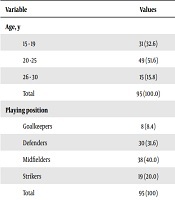Dietary Intake and Body Composition Characteristics of National Football League Players
Keywords:
Body Composition, Fat, Football, Dietary Intake, Protein, CarbohydratesAbstract
Background: It has been well documented that adequate body composition characteristics and good nutrition practices play significant roles in maintaining good health, proper immune functioning, muscle growth and repair, and delaying fatigue in continuously intense athletic performance. It would be incumbent, however, to support imported information with local data to enhance effective implementation. Objectives: To examine dietary intake and body composition characteristics of National Football League Players in the Ashanti region of Ghana. Methods: Cross-sectional study was used. 95 football players from the premier, 1st and 2nd divisions of the Ghana National Football League were recruited. A 24-hour dietary recall was used to assess the dietary intake of the players. Body composition characteristics of body mass index, percentage (%) body fat, visceral fat and percentage (%) muscle mass were measured. Results: There were 8 (9.3%) goalkeepers, 29 (33.7%) defenders, 34 (39.5%) midfielders and 15 (17.4%) strikers. 42 (44.2%) of the players ate twice per day. Players within age group of 20 - 25 (49, 51.6%) had the highest mean total energy intake (2342.96 ± 848.18), carbohydrates (324.18 ± 106.35), proteins (75.54 ± 23.94) and fats (83.00 ± 50.76). Midfield players had the highest mean total energy intake (2216.26 ± 803.87), carbohydrates (315.74 ± 121.02), proteins (74.23 ± 26.35) and fats (71.59 ± 34.32). 82 (86.3%) had normal weight, 79 (83.2%) normal % body fat, 45 (47.4%) had very high % muscle mass. Conclusions: The sample in this study has low total energy intake compared to other studies. Insufficient nutritional diets could suggest the reason for the low energy intake. If low energy intake persists, the players might be at high risk of chronic cardiovascular diseases and diabetes conditions.
Downloads








